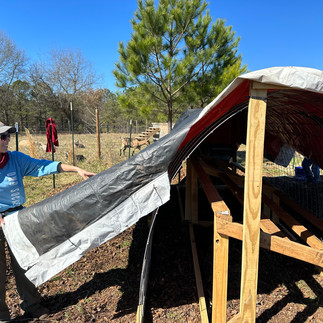
Bed Building our New Gardens
In late December, we started converting the old chicken runs into new produce gardens. The manure-rich soil has been aging since the chickens moved off in fall. The first garden we worked on used to be filled with a whole bunch of leaves, which the chickens broke down into soil. There was other evidence that the chickens had lived there, like a peach pit from their food scraps, and the occasional feather.
To create the garden beds, we measured out where the beds would go, and then dug the soil out of the paths and added it to adjacent beds. This means the most soil possible ends up in the beds, where it can be used by the plant roots.
After building the beds, we added mulch to the paths. The old chicken houses will stay in the garden and work as lovely trellises. This garden will hold a wide variety of produce, some of which will be in the ground before the frost date in April. There will be things like collards, kale, bok choy, turnips, beets, and more in the spring, and then things like beans, tomatoes, and peppers in the summer.
The other garden we prepped was also an old chicken run, although it had much fewer leaves in it when the chickens lived there. I could see the difference in the soil, and the higher side of the garden had clay not too far down. But I don't think this garden soil is necessarily less ideal; for example, it may hold moisture better than some of the leaf-y soil. I'll be interested to see if I can tell the difference in plant health, although I'm growing different produce here, so it may be hard to tell.
After I added the soil from the paths to the beds, I smoothed them out with a rake. In this garden I added leaves instead of mulch to the paths, mostly because the paths were pretty deep, and it was easier to add a whole lot of leaves than a whole lot of wood chips. Sometimes time saving is the way to go. Then we added simple trellises down the middle of every bed (that didn't already have the old chicken house). The first things to go into this garden will be snap peas and snow peas, and they need something to climb!
What Fun Guys
Even though a lot of our gardens are new or in transition, and they don't have a lot of green plants in them, there is still lots of life to be found. The leaves and mulch we bring into the gardens are full of fungus, insects, and other organisms. All the winter rain has kept things moist and vital for these welcome friends. I believe the yellow blobs on the leaves below are a kind of slime mold. The white threads in the mulch are mycelia - the intricate structure of fungus. I also saw quite a lot of worms while bed building the gardens. All of these organisms take part in the process of creating soil, so they're always a welcome sight.
Building the Chickens' New Home (Again)
The biggest project for February was to build the chicken flock's new pen. If you want a reminder of why they've been moving around, check out our last 2 blogs! But long story short, they are moving off a space that needs to be turned into a flower garden by April, so we had to build their new home as soon as possible.
The first step was to pick a good spot, because they won't be moving again for the foreseeable future (thankfully). We picked a spot with some trees for shade in the summer, that was near our bunnies and one of the pastures the herd rotates through. Then we covered the area in leaves. This way the chickens will have a lot to forage around in, and they can generate soil we can harvest for use in our gardens. Then we drove t-posts around the perimeter for the fence, and constructed the lumber foundations of their hoop houses.
Next, we built and placed the roosts for inside their hoop house. We added ending frames for stability, and put in the 4 cattle panels that make up the house structure. We zip-tied the panels together and connected them to the end frames.
Then we covered the house with a thick, waterproof 'tarp' (an old billboard), and of course connected it to the cattle panels and the ends. We also built a half-size cattle panel house which holds their nesting boxes, food, and water.
For the fence, we used chicken wire from the old chicken runs, and, in a complicated process involving cross-fencing, we also used some of the wire on the current chicken run. We connected the fencing to the t-posts, put on a door, and then it was time to move the flock.
Although at this point we are surely the world's leading experts on catching free-range chickens, it is still an exhausting process to catch 86 hens. The first few you can just reach down and pick up, but they catch on pretty quick, and some are much more wily than others. Eventually, through teamwork and strategy and some silly shenanigans, we were able to catch all the chickens in batches and move them across the farm to their new home.
They seemed very happy for new land and leaves to explore. As evening fell we added the finishing touches, like the electric wire along the outside bottom of the fence to keep out enterprising predators. It felt very good to finally finish this project. It took us a couple of weeks to build what we needed to, gather materials, and move them. But even more than that, it was the end to a project that really started in October, when we first combined the flocks to temporarily live on the flower garden and help us control the weeds there. Now, months later and in a new year, the chickens have a nice, new, permanent home, and the garden they vacated can be readied for spring planting.
Oh, and how could I forget! We of course also moved Ducky along with the chicken flock. He was much easier to catch than the chickens, and he's very soft. He seemed happy to get to waddle around his new home, while the herd looked on.
Spring Chicks
This February we got baby chicks! We add new chickens to our flock every year, mostly to account for other chickens getting older and no longer laying eggs. This year we have almost 50 new chicks! When they start laying in about 5 months we'll have more eggs to share than ever before.
Since there are quite a lot of them, they quickly outgrew their first home. We moved them to our 'chicken trailer,' where they'll have room to run around and grow up happy.
Projects around the Farm
Even as our chickens and main gardens get a lot of attention, there's always other projects to do around the farm. We have a row of asparagus that was one of the very first things that we planted when my parents moved to the land. It's a little bit away from our gardens, so it had filled up with quite a lot of weeds. I spent a couple days clearing the row, and then added organic chicken-manure fertilizer and leaf-compost soil.
Asparagus can't be harvested heavily until about the third or fourth year of growing in the same place. So hopefully they are happy being weed-free, and this spring we can benefit from one of the original planting decisions we made on the farm back in 2019.
Another project we did this January was actually a surprise. Last year, in the space between the asparagus and one of the new gardens, my dad had dumped a thick layer of leaves right onto the field, and then sown ornamental corn and pole beans. The patch was productive through the fall, and then we left the stalks in place all winter.
After I weeded the asparagus, I wanted to see if I could clean up the patch, so I start removing the corn stalks. Immediately I noticed that the typical red clay of our fields was aerated and full of organic matter under the corn roots. Also, although there were weeds, it was patchy fescue and a couple brambles. Between the suppression and decay of leaves and the growth of corn, the patch was on it's way to being a cultivated garden space. Best of all, there was barely any Bermuda grass (our greatest enemy)! Over the course of a couple weeks, I cleared the area, and laid down rows of soil from composted woodchips and coffee grounds. We threw up a fishing line fence to keep the deer out, since they like to walk through this area.
In February, I sowed a cover crop of field peas and oats into the beds. In the early summer, we will plant beans and okra crops into the cover crop debris. This is one of our first major uses of cover crops in our gardens; I'm excited to see how it goes!
Over in the flower garden, we've started working on the 'mint corridor'. Using bulbs, transplants, and seeds, we are filling a strip along the edge with perennial plants we can use in bouquets. There are daffodils, shrubs like forsythia, and a wide variety of mints, like mountain mint and apple mint. While the chickens were on the garden, we protected the young plants with temporary fencing, although they did poke their heads through and eat up some of the cover crop seeds.
Flower Garden Spring Cleaning
Over in the hardy annual flower garden, it was time for a refresh. Using a stirrup hoe, we quickly weeded the paths, and then added a new layer of mulch.
There were also weeds in the beds themselves, which we pulled by hand. These nice spring plants then got distributed to our chickens and bunnies. (In the second picture below, you can see a little flock of 4 hens and rooster. They are a naughty family, who kept escaping the other run they were in, so now they live in their own smaller pen- that has a netting roof to keep them in.) The weeds were a great treat for everyone to munch on.
Old and New
In December, we had a particularly cold couple of days, when the temperature dropped to 7 degrees. Almost all of our winter vegetables, and a lot of the hardy annual flowers, got fully killed by this level of cold. This is pretty early in the winter for such cold to happen, but such is the way with plants and weather- what happens, happens. I think my onions will recover, but not much else. This just means I'll have a bit more planting to do in the spring.
Speaking of planting in the spring- it is already beginning! One week ago, I direct sowed my first produce of the year - a variety of snow peas and snap peas. Inside, Rosa has been hard at work starting and caring for an early round of spring flowers. We've also started some early lettuce. It's wild to see how tiny some seeds start out, knowing how much growing they can do in just a month.
The Earliest of Blooms
Although there is still the ever-present chance of frost, spring is starting to show in the earliest of buds. Daffodils and Hellebores are blooming, and the buds of our young orchard trees, like this peach, are right around the corner.
When your days are tied very closely to plants, the weather, and warmth, January can be a bit of a tough month. (It's probably a tough month regardless). But there's a lot to be encouraged by, from our progress in the gardens to the chirps of new baby chicks. If you see a daffodil patch while you're out and about, maybe take a little sniff! I always do.
This was a long one, so if you made it to the end - thanks for reading!
-Lillian




























































































































































Comments